Selecting camera gear for safari is complicated if you’ve never been on safari prior, and/or aren’t a professional wildlife photog sitting on a mountain of gear. Most of us have never really considered how long of a lens we may need in order to get great shots of animals from a jeep – and more importantly, how much that lens/camera combination might cost us, or how big/heavy that lens might be.
If you’re planning a safari and have anything more than a passing interest in photography, my guess is that you’re dreaming of bringing back images that you’d be proud to (theoretically) publish in National Geographic. And that’s fair, and we should all aim high. That’s what I was dreaming of, when I went on my first safari game drives in October of 2015 in Kenya’s Maasai Mara National Reserve (personal trip – not a professional assignment).
Below are details on my experiences insofar as they relates to selection of camera gear for my first safari, and my attempt to balance weight, bulk, cost, and quality photographic output.
Spoiler: I ended up carrying/shooting what I now consider the absolute bare minimum of equipment for wildlife photography in the Maasai Mara. Did I get by? Yes. Would I change some things? Yes. But let’s not get ahead of ourselves.
The first thing in my process of choosing camera gear for safari was to attempt to answer the questions of how the conditions of my game drives and how that would affect what I should bring along.
Choosing Camera Gear for Safari: Burning Questions
- How close will I actually be able to get to the animals in the area I’m visiting (Maasai Mara in my case), and accordingly, how long of a lens do I really need to bring?
- What will the light conditions be, especially in the mornings and evenings, and relatedly, how fast does my long lens really need to be?
- If I’m carrying a heavy lens (for example, 2-3 kg), will I feel comfortable hand-holding it all day? If I don’t feel comfortable hand-holding, will the jeep I’m in have bars to which I can mount camera support? How can I even find out the mounting situation on the jeep I’ll be in?
- What if the animals get really close to the jeep – will I have to change lenses in rather dusty environments? Should I bring two camera bodies to avoid changing lenses?
- Do I even own any of this gear? If not, how expensive will any of this gear be to buy or rent?
Answering these will take a little time. Read on.
And another complication, in my case…
Just to make things more complex, my Africa trip was scheduled for two uninterrupted months between Kenya and Ethiopia, and I was traveling independently (see: backpacking) so I had to be willing and ready to continue to lug any lenses and camera bodies I brought along for safari – so weight, size and versatility of my gear was a serious concern.
What about renting a lens just for my few safari days, you might say? Well, given my trip’s duration, this was potentially quite a large expense, as I’d have to rent for two full months. Shipping a lens home was more or less out of the question as well – Kenya’s (nor Ethiopia’s) postal service isn’t known for its reliability, and FedEx charges were going to be at least a few hundred dollars to get a heavy lens back to the US. Beyond that, I couldn’t locate any photography stores in Nairobi that rented long lenses, either (if you know of a place to do this, please share in the comments).
The photo gear I ended up bringing along:
After research and thought, I landed on the following gear for my Maasai Mara game drives:
- Nikon D610 full-frame DSLR body
- Nikkor 70-200mm f/4G ED VR plus a Nikkor TCE-14E III 1.4x teleconverter
- Ricoh GR fixed 28mm equiv., APS-C camera (pocketable)
- iPhone 5s
- (to be fair, I also had a Nikkor 18-35mm f/3.5-4.5G ED, as well as a Nikkor 50mm f/1.8G along for the remainder of my trip, but I didn’t mount/use either in the Maasai Mara)
- Associated batteries, chargers, etc. I didn’t use any filters while in the Maasai Mara.
I realize that this gear isn’t cheap by any stretch of the imagination – but compared to the prices of a lot of the equipment that serious wildlife pros bring along, this is really not a huge or pricey gear package at all. Nope.
Here’s a run-down of why I chose each particular piece of gear for my trip.
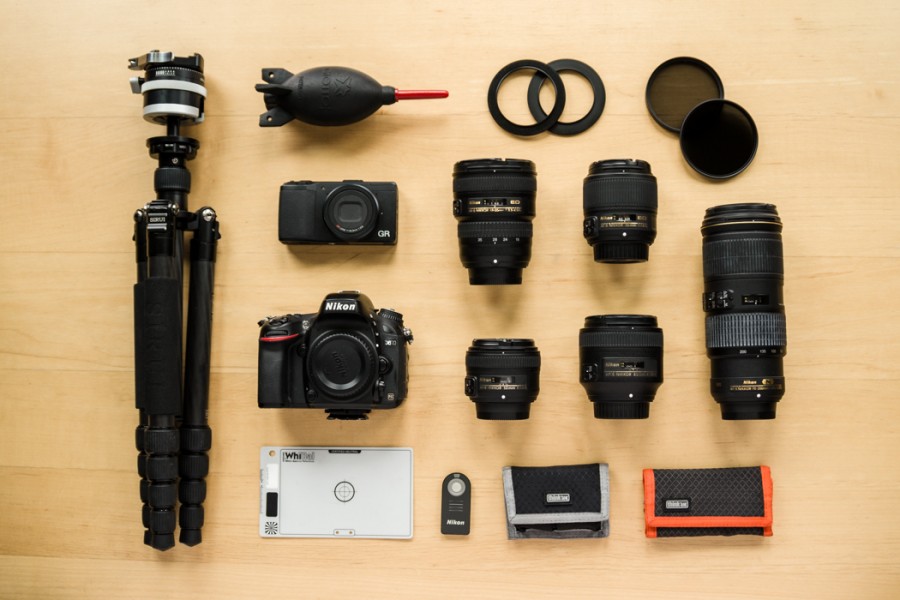
Related Post: Matt’s Camera Gear for Travel (click through the image)
Primary Camera Body: Nikon D610 full-frame DSLR
I’ve owned this body for about two years now, and feel very comfortable shooting with it and like the images it produces. As the “gear I already had” it was the obvious choice.
The D610’s capable 24 megapixel full-frame sensor gave me images of 6016 x 4016 pixels, providing for a reasonable amount of ability to crop into my images (given that the image was sharp in the first place, of course).
Though the D610’s maximum frame rate per second and its autofocus module is by no means up to the level of a flagship body like the Nikon D4s, I figured it would suffice for my first safari. I was mostly satisfied with the speed of the camera’s operations, though if I would have needed to track fast action throughout the frame, I would have been in trouble on the D610 due to the small AF area, to be sure.
Secondary Camera: Ricoh GR
I used my Ricoh GR (Ricoh GRV to be precise, as there are multiple releases of this camera, all called “GR”) as my “wide” camera (28mm equiv. fixed lens, f/2.8 max. aperture) for landscape shots and just in case animals got really, really close to the vehicle (they never got THAT close, I’ll admit). The GR’s 16.2 megapixel APS-C sensor doesn’t offer a massive amount of resolution, but it’s enough for most scenarios, and I really like the way this camera renders images. Good times.
For Video: iPhone 5s
This is my perennial “video camera” on trips these days. It’s just always on me, and if I want to catch a general moment to share with friends/family that really gives them a feel for where I was, this is the best way. The iPhone 6s was available by this point, but I hadn’t upgraded to it and felt fine with the 5s model given what I was using it for.
One thing I would never consider using this camera for: safari wildlife photos shot from a jeep. I saw a lot of tourists shooting distant animals on their smartphones while in Maasai Mara, and I really feel for whomever has to look at those photos later. Sorry guys.
“Long” Lens for Primary Camera: Nikkor 70-200mm f/4G ED VR, plus a Nikkor TC-14E III 1.4x teleconverter.
This combination gave me a focal range of 98-280mm at a constant f/5.6 (the 1.4x teleconverter reduces the speed of a given lens by a full stop). Was this combination long and fast enough for photography in the Maasai Mara? Yes and no. I’ll get into that a bit later.
Brass tacks: the 70-200 f/4 is quite a sharp lens with top-notch image stabilization and good control over flare and chromatic aberration (CA). A bit of distortion does exist, but it’s tolerable and easily corrected in postproduction. Check out reviews by Ming Thein or CameraLabs for more information.
The 70-200 f/4 runs $1400 new, weighs in at a relatively lightweight 850g, and has a form factor of 7.87 x 17.78 cm. I picked it up used for $1000.
The 1.4x teleconverter goes for $500 US new and weighs just 190g. Not crazy cheap, not ridiculously expensive.
I’m aware that this isn’t the obvious telephoto for the job – wildlife photography, that is. But remember, I had a two month trip to plan for, and a variety of photography scenarios to deal with along the way. I used the 70-200mm f/4 (sans teleconverter) on the remainder of my two month trip as a medium telephoto for things like portraiture, and general compression effects on any subject for which I saw fit.
Before I landed on this lens/teleconverter combination, I considered just about every other telephoto on the market though – the below is what I learned through that somewhat painful but edifying experience.
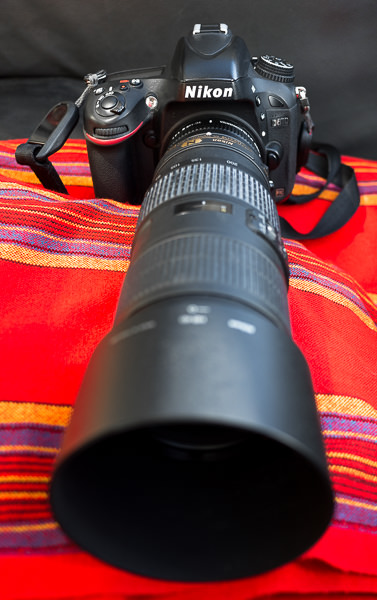
The Nikon D610 with Nikkor 70-200mm f/4 VR and Nikkor TC-14E III teleconverter mounted, on a Maasai blanket, inside our jeep. (I bought the lens used, and the zoom ring barrel has always been chalky-looking for some reason – but image quality is unaffected. Weird.)
Other “Long” Lenses Considered:
Ready for some nerdy gear talk? Well here it is. I’ll go through each long lens I debated using for my trip, and what I liked, and what I didn’t. Ready? Go.
I thought long and hard about just picking up a Nikkor 70-300mm f/4.5-5.6G IF-ED VR and being done with it. These lenses are relatively cheap ($500 US) and of comparable weight (745g) to the 70-200mm f/4G. But in the end, after reading reviews and camera forums, it seemed that majority of 70-300mm lenses suffer in their resolving power between 200-300mm, especially toward the extreme long end of the zoom. This holds true for Tamron and Canon versions of this type of zoom as well. So those were out.
The Nikkor 28-300mm f/3.5-5.6G ED VR superzoom was never a lens I wanted to take along either, really. I know some people celebrate the versatility of this lens, but superzooms are generally optical compromises, especially at their extreme long ends. Additionally, I figured that especially for the days of my trip on which I wasn’t using the teleconverter, the 70-200mm f/4 would render images I preferred over this lens.
I also nixed the Nikkor 80-400mm f4.5-5.6G ED VR, as it’s both more expensive ($2300 US) and a bit heavier (1.57 kg) than the 70-200mm f/4 and has seriously mixed reviews (it’s been noted as a bit of an unreliable “dust pump” by some wildlife photographers, though on balance, photographers like Thom Hogan seem to get a lot of utility from it). The biggest reason why I didn’t choose this lens was the lack of use I would have for a slow, heavy 80-400mm on the rest of my two month trip through Kenya and Ethiopia though.
The Nikkor 300mm f/4E PF ED VR plus a teleconverter initially looked like a great choice as a long lens option for safari photography given its optics, non-astronomical cost ($2000 US – I admit this is a lot still, but not compared to some of the other lenses I get into below!) and weight (755g), but given well-publicized problems with the vibration reduction of this lens causing blurry, unusable images for images shot with shutter speeds around 1/125 second, I didn’t feel comfortable buying this 300mm as of yet. Note: Nikon has offered a firmware fix for this problem as of Spring of 2015, but some users still report problems with the VR of this lens. Hmm.
The Nikkor 300mm f/4D IF-ED is a high-resolving, well-received lens at a reasonable cost ($950 US) and weight (1.44 kg) and functions with teleconverters, but it lacks any sort of image stabilization. I expected to be shooting hand-held all day in the Maasai Mara and would rather have some sort of image stabilization to help with my shaky hands, so I passed on this lens as well.
The Nikkor 200-400mm f/4G ED VR II is optically quite nice, fast, and versatile, but these positive traits don’t come without consequences. This lens is large (12.45 x 36.58 cm), heavy (3.36 kg), and really expensive (around $7,000 US). I didn’t even think about dragging this thing along, but I could see why some pros would want it onhand.
The Nikkor 200-500mm f/5.6E ED VR wasn’t available before I left, but looks like a promising telephoto for those of us that want a long lens on something of a budget ($1400 US). At a weight of 2.09 kg and dimensions of 10.8 x 26.75 cm, it’s still pretty large and heavy for handheld work though (or extended independent travel for that matter). Might have to pick one of these up at some point – but not for this trip.
In the same price tier as the Nikkor 200-500mm f/5.6E ED VR, the Sigma 150-600mm f5.0-6.3 DG OS HSM (two models available: SPORTS and CONTEMPORARY) comes at a somewhat reasonable price ($1000 and $1700 US, respectively) as a long telephoto zoom, but is still too large (around 10 x 26 cm) and heavy (around 2 kg) for extended travel and/or handheld work – plus, at this time I’d prefer to work with the Nikkor 200-500mm, discussed above, over this particular lens.
The Nikon high-end telephoto prime lens world is at present comprised of Nikkor 400mm f/2.8E FL ED VR, Nikkor 500mm f/4E FL ED VR, Nikkor 600mm f/4E FL ED VR. These things are sexy and professional as hell, but they’re really heavy (3 kg+) and incredibly expensive ($10,000 US+). I couldn’t drag that kind of weight and liability around for two months of travel, no way. That said, I’d LOVE to shoot African wildlife on one of these primes, if only someday! It’s on my list.
How did it go, in practice?
Pretty well for a first go, I’d say. I spent two full days from about 7:00 AM to 5:00 PM inside the reserveand encountered a great deal of wildlife. Being in a safari game park for the first time is absolutely amazing and I loved every second of it.
Photographically, I’m pretty happy as well, though there’s definitely room to improve. Here’s what I learned and would tell others, in Q/A format.
Was a maximum focal length of 280mm long enough for photographing wildlife in the Maasai Mara?
Realistically, no. But I got away with some good shots anyhow.
Thanks to plenty of off-road jeep tracks in Maasai Mara National Reserve, you can get PRETTY DARN CLOSE to the animals. So with 280mm, I could cover BIG animals in FULL BODY SHOTS, mostly. Think grazing buffalo, sleepy lions, tall giraffes, zebras that seemed to stand in the road until the last second, and other animals that weren’t terribly skittish.
What I couldn’t really do well was get up close with shy, wary animals like the eland, or get anywhere NEAR close enough with small animals like jackals. Further, I couldn’t ever really get close enough to pull off tight detail shots of big animals either. If you want to frame up these types shots without cropping, you’re going to need at LEAST 400-600mm of focal length (full-frame equivalent). At my next go, I’ll likely drag this kind of glass along if my trip allows for it, just to get some different types of shots of animals than I got on this trip.
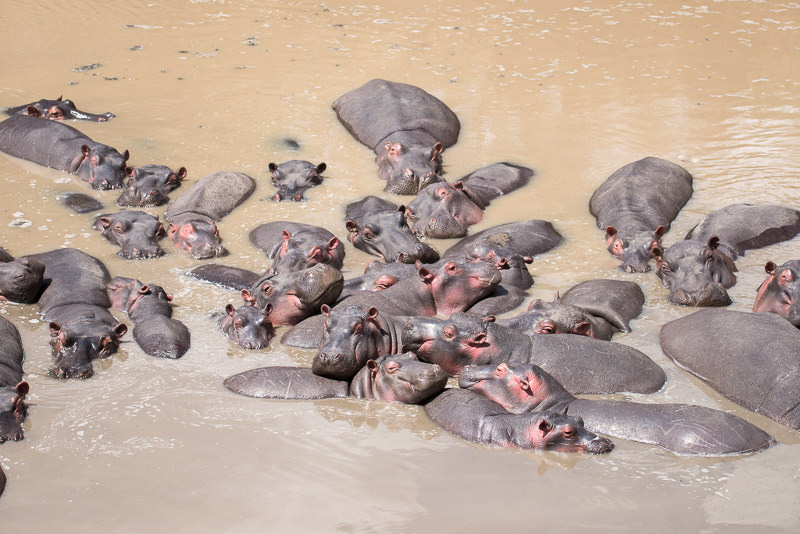
An example of what 100mm looks like on the D610 – this is the widest option on the D610 with 70-200 f/4 plus 1.4x teleconverter. Shot from the bank of the Talek River. Image is not cropped.
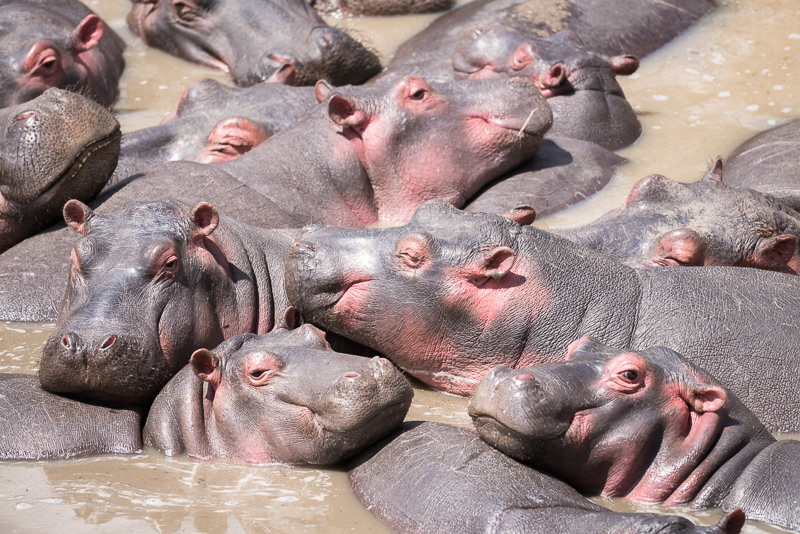
This is what 280mm, my longest available focal length, looks like comparatively. This was shot shortly after the previous image, from the same vantage point. Image is not cropped.
What was entirely IMPOSSIBLE with a max length of 280mm: stills of birds was basically completely out of the question at a maximum focal length of 280mm. If birds are your priority, get as long of a lens as you can. 500-800mm (full frame equivalent) would be best.
Note that I can really only discuss the conditions in the Maasai Mara here – if you’re visiting other countries or other parks, you may need to consider those parks individually insofar as what focal lengths would be appropriate for your game drives.
Was a maximum aperture of f/5.6** fast enough?
Mostly yes.
The first thing anyone should note is that roaming the Maasai Mara National Reserve after 7:00 PM is prohibited – so unless you have some kind of special access, you’ll be in the park during daylight hours. This means you probably won’t have to push your ISO to extremes. I didn’t have to.
Almost 50% of my exposures were at ISO 100, and less than 10% of shots required anything above ISO 1600. Our weather ranged from intense, cloudless daylight to downpours and thick cloud cover.
What does this mean? You don’t need the absolute FASTEST lens in the Maasai Mara just to get appropriate shutter speeds for in-focus, properly exposed images. Still, if I could get down to a max aperture of f/4 at the long end, I would – because the option of stopping down a bit for greater sharpness, or of maintaining creamier backgrounds while wide open is obviously appealing.
**if you recall, a lens with a maximum aperture of f/4 with an addition of a 1.4x teleconverter loses a full stop, for an effective aperture of f/5.6.
What do you think about the TC-14E III 1.4x teleconverter paired with the 70-200mm f/4G VR, insofar as image quality and workability?
The addition of the 1.4x teleconverter to the 70-200mm seemed to produce ever-so-slightly softer results at pixel level than shooting without use of the TC, but not by any means intolerably so. I don’t have any controlled tests to prove this though, so you’ll just have to take me at my word for now.
As for autofocus: some teleconverters can negatively affect the ability and speed of the camera/lens to autofocus – but I didn’t see that problem with this combination. If the autofocus was slower, it wasn’t really noticeable in this scenario.
All and all, not bad – but a 300mm f/4 prime lens WITHOUT a teleconverter would doubtless outresolve/outperform this combination by a noticeable margin. I’m guessing a 300mm f/4 prime plus 1.4x TC (for an effective 420mm on a full-frame camera body) would also out-resolve the lens/TC combo I was using as well.
Caveat: a 300mm prime would of course lack the versatility of being able to take off the teleconverter to return the lens to a 70-200mm f/4 though, and I definitely enjoyed being able to do this for the remainder of my two month trip in Kenya/Ethiopia, which was time that was NOT all focused on wildlife. So there’s that.
Do you wish you had brought a different lens, given the complexities of your trip?
Not really, no. The nature of my trip demanded that I keep things RELATIVELY small and lightweight given that I was traveling independently for two full months, and the 70-200mm f/4G ED VR plus 1.4x teleconverter was a good and versatile solution for the problem of quality-meets-portability.
Is it the BEST lens combo for safari? Again, not a chance. But it still got me some images I like.
How did the Nikon D610 perform?
I can’t say the D610 is really the ideal DSLR body for wildlife photography due to its autofocus module’s limited size and sensitivity compared to other Nikon offerings. As of January 2016, I’d prefer to carry a Nikon D4s, D810 or D7200, or – better yet – the yet-to-be-released Nikon D5 or D500. All of these have autofocus capabilities that should beat the D610 squarely. That said, the sensor on the D610 still renders images really nicely – so with slow moving or static subjects in the Maasai Mara, I didn’t feel like I was really missing much. And most of my subjects were relatively slow moving – I didn’t get to see anything like cheetahs running down prey on wide plains, unfortunately (though we tried for this!).
Beyond just a discussion of Nikon products: Canon and Sony also have great full-frame and APS-C (crop frame) offerings, of course – good gear is good gear – but I’m not going to get into their products here in an attempt to keep this post from becoming even more monstrously long than it already is. More: if you’re a micro 4/3 camera user, Olympus and Panasonic’s offerings can get you more perceived “reach” with considerably smaller lenses too – but I prefer larger sensors for their increased dynamic range and look, personally.
Did you wish you had a second camera body, or additional lensing beyond what you brought?
A second DSLR camera body honestly would have been very convenient to have along, but I would want an even longer lens on it than I was carrying already, so this would enter me into a whole new world of weight and bulk. On this particular trip, that was out of the question.
What about stabilization in the jeep?
Pretty much any form of stabilization (monopod, tripod, clamp, beanbag) would have been more or less useless in the small Suzuki jeep I rode in, especially considering the relatively lightweight equipment I was using. Being untethered and handheld meant I could move quickly and change my camera angle without restriction, which was a benefit to my photography.
If you’re using a 2-3 kg lens for your safari, you may want to talk to your safari operator about what jeep you’d be doing your game drives in so you could think about your lens stabilization options or mounting points. And of course, be ready to go handheld as necessary.
Should I bring a speed light or any other type of lighting?
I can’t really speak to this as I haven’t explored it yet. I know some photographers bring lighting equipment along though. Further research needed.
How much did you shoot in your two days of game drives?
I shot about 3500 RAW exposures in two days in the Maasai Mara – about 3000 on the D610, and 500 on the Ricoh GR. This took up about 100GB of memory on SD cards in total. I backed up images to a MacBook Air each night.
I imagine I’d shoot a bit less on a subsequent trip – but the newness of the wildlife and the landscape was really exciting for me, so I kept on clicking. No regrets – for a first go at safari photography, semi-redundancy of shots of a given animal helped me be sure I was hitting focus, or that I could avoid getting stuck with only a shot of an animal with closed eyes or an expression/body position which I didn’t like. Options are good, and don’t cause problems, provided you’re not on deadline.
Were you satisfied with your results? What advice would you give anyone visiting the Maasai Mara for the first time about shooting there?
Honestly, this was a bit of a learning experience for me, as I expect it would be for any photographer on their first safari. Beyond selecting your camera gear carefully, I would
Practice with your camera and lens combo before you go. You stand little chance of working photographic miracles if you don’t know your gear well.
Further: if you decide to rent a lens or camera body for your trip, you should pick it up (or ship it in) at LEAST a few days before you go so you can get to know it. Don’t get it the day before you go if you can avoid it – rental gear needs to be tested out before it goes out in the field, especially if you’ve never used the lens or camera in question.
Make sure your long lens is sharp at its long end before you go. If your telephoto doesn’t resolve well / isn’t sharp at its extreme long end, you should know that long before you take it to Africa with you. Shoot some varied exposures in varied lighting conditions with your lens/camera combination and view your results on the biggest monitor you have. Taking your camera to the zoo or somewhere else that has large animals is an obvious choice for some real world tests.
Don’t bring just one battery for your camera on game drive days. This applies especially to those of us that are shooting on mirrorless cameras like the Sony A7 series – they go through batteries at an alarming rate.
Don’t forget your lens hood for your long lens either. Lens hoods will not only flag off unwanted light from entering your lens in bright conditions, but keeping a lens hood mounted will also help protect your lens from airborne dust and rain as well. And for the errant piece of dust or drop of rain on your lens’ front element, be ready with a rocket blower to clean the lens without smearing anything on the optic (and some cleaning cloths as well, just in case).
Find out what times of day you’ll be doing your safari game drives in any given reserve or national park. If your game drives start before sunrise or continue after sunset, this may affect your equipment choices.
What gear would you bring to the Maasai Mara for your second trip, if you had your choice?
If I had to speculate about choosing a photo gear package to take along to the Maasai Mara today (January 2016), and I wasn’t traveling for two continuous months, I’d probably opt for a setup something like this:
- (2) Nikon D4s, D810 or D750 full frame DSLR body (a mix of two different models of these bodies would be fine)
- (1) 200-500mm f/5.6 VR lens, mounted on the primary body, for distant wildlife
- (1) 70-200mm f/2.8G VR II lens, mounted on the second body, for closer wildlife
- (1) Ricoh GR, for wides
- (1) iPhone
Note that the 200-500mm DOES accept teleconverters- but I’d probably shoot it without one to preserve image quality and avoid hitting a max aperture of f/8 or slower. Also, If there was a way to bring along a 500mm or 600mm f/4 prime as a rental (instead of the 200-500mm), I’d love to give that a try of course.
Also note this: I haven’t actually shot the Nikkor 200-500mm f/5.6 VR yet – so this is entirely speculative. But it gives you an idea of where my head’s at.
One additional thought – population density in your jeep matters photographically!
For my two days in the Maasai Mara, I rode in a small Suzuki jeep with cutouts in the top. I rode with a driver and a guide only, so the back seat was mine to sit in or stand on. This meant I had access to 360º views, and could point my camera anyplace I liked. This was AWESOME and gave me as many opportunities as the wildlife allowed me to shoot and shoot and shoot.
If I had been in a jeep with, say, six other people, I would NOT have had all the access to camera angles that going solo allowed me, thanks to tripping over other people, and the fact that those people would all want to take pictures too. Remember, just because you brought the biggest lens doesn’t mean you’re allowed to claim the best camera position every time!
So if appropriate, see if you can ride in a jeep with LESS people if wildlife photography is your goal.
More information regarding selection of your camera gear for safari:
If you’re planning a safari with photography in mind, I’d highly recommend you check out the below link to begin. Thom Hogan is much more experienced than I with safari photography and has a lot of critical and keen perspectives about photography gear and its uses.
Thom Hogan: How To Think About Equipment For Safari

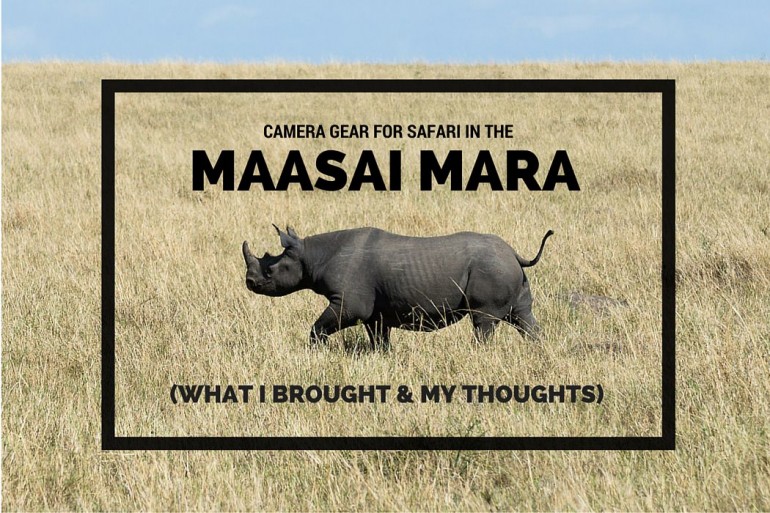
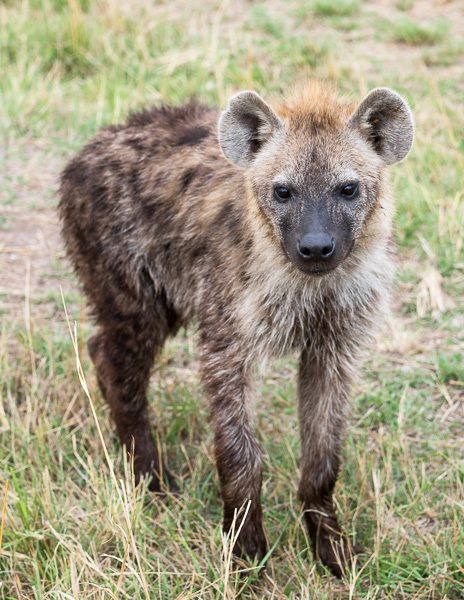
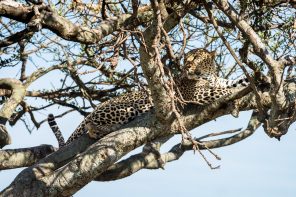
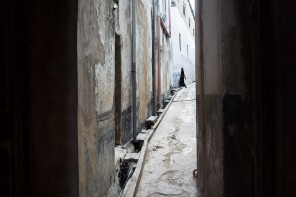
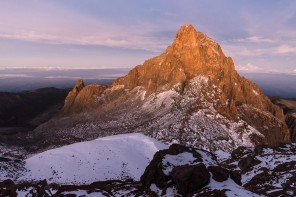
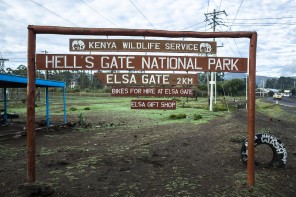
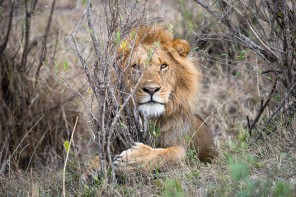
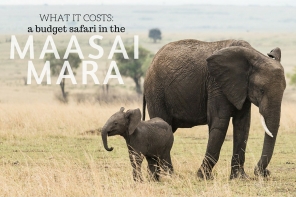
After reading the whole article, I have to congratulate you for the exhaustive work, and I hope I won’t regret I am not going to follow your advice, haha! I have a D610 as well, but I work with fix lenses only… and the longest focal distance I use is 85mm 1.8G. I hope animals get close enough and I will trust in the sharpness of the lense and the cropping capabilities of the D610 🙂 I like the pic of the hippos with only 100mm… so I guess it is not impossible
Next time I go out for wildlife photography, I’ll probably buy or rent something that gets to a minimum of 400mm (full frame equivalent), even for big mammals if I can. It was just tough to do that on this trip given how many things I was trying to do and how many places I was trying to visit! Thanks again for your comments Juan!